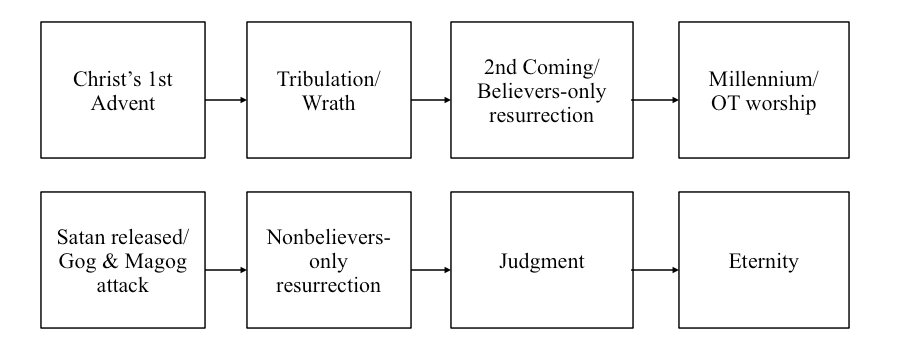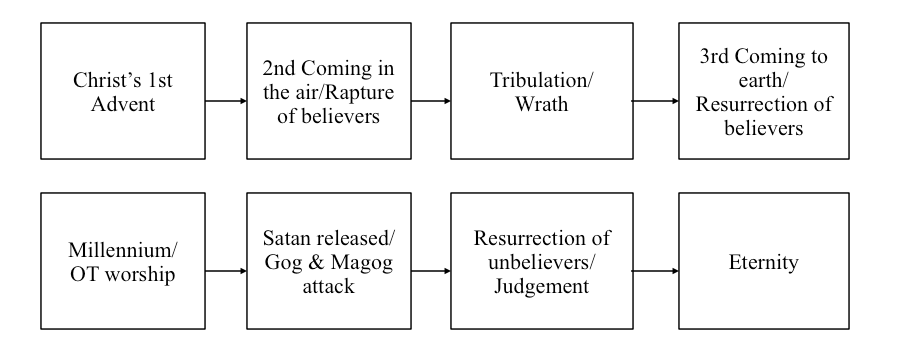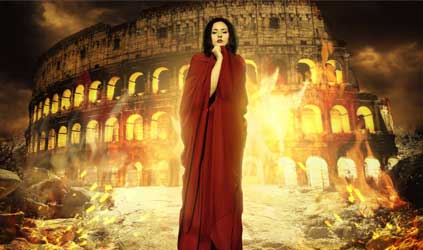January 14, 2018
Steve Sabz

Roman numeral M, mille, 1000, one thousand, reflected on water, isolated on white, 3d render (Photo by kostyuchenko)
1. Introduction
What is the millennium? This is a term applied to the "thousand years" reign of Christ with resurrected saints described in Revelation 20:1-7. The first known use of the word millennium was documented circa 1638.1 Its etymology comes from the Latin mille which means thousand, and annus which means year. The more common, non-theological, vernacular denotes a literal period of 1000 years. For example, counting from the beginning of the Christian era (i.e., 1 AD), human history is currently in its third millennium, which began on January 1, 2001. There are four main interpretations of what is termed the millennium found in the last book of the Bible called, The Revelation of Jesus Christ to St. John:
Then I saw an angel coming down from heaven, holding in his hand the key to the bottomless pit and a great chain. And he seized the dragon, that ancient serpent, who is the devil and Satan, and bound him for a thousand years, and threw him into the pit, and shut it and sealed it over him, so that he might not deceive the nations any longer, until the thousand years were ended. After that he must be released for a little while. Then I saw thrones, and seated on them were those to whom the authority to judge was committed. Also I saw the souls of those who had been beheaded for the testimony of Jesus and for the word of God, and those who had not worshiped the beast or its image and had not received its mark on their foreheads or their hands. They came to life and reigned with Christ for a thousand years. The rest of the dead did not come to life until the thousand years were ended. This is the first resurrection. Blessed and holy is the one who shares in the first resurrection! Over such the second death has no power, but they will be priests of God and of Christ, and they will reign with him for a thousand years. And when the thousand years are ended, Satan will be released from his prison.
The apostle John in Revelation 20:1-7 [italics mine] (pre-70 AD)
As you can see from the italicized text above, the phrase "a thousand years" or "the thousand years" is used six times. From this passage, various theologians throughout church history have come up with four main views of the millennium: the historic and dispensational versions of premillennialism, postmillennialism, and amillennialism.
The prefixes pre and post denote the timing of Christ’s return to earth. For example, in the historic and dispensational premillennial views, Christ returns before (i.e., pre) the millennium begins. Conversely, postmillennialism asserts that Christ returns after (i.e., post) the millennium has ended. In the fourth millennial view, amillennialism, the "thousand years" reign of Christ with his resurrected saints is an event that began in the first century AD and will end at his, still-in-the-future, Second Coming. In this way, the "thousand years" is symbolic for an indefinite time-period, almost 2000 years so far, and is situated in heaven.
A summary of the four main millennial views with seven important characteristics is shown below in Table 1. A more detailed description of each millennial view will be provided in the following pages.
Table 1. Characteristics of four millennial views
|
| VIEW |
WHERE |
WHEN |
TIME |
WORLD |
ISRAEL/CHURCH |
2ND COMING |
RESURRECTION |
| Amillennialism |
heaven |
now |
long, indefinite |
gets worse |
single entity under Christ |
1 stage, after millennium |
single |
| Postmillennialism |
heaven and earth |
future |
long, indefinite |
almost perfect |
single entity under Christ |
1 stage, after millennium |
single |
| Historic Premillennialism |
earth |
future |
1,000 years |
gets worse |
single entity under Christ |
1 stage, before millennium |
double |
| Dispensational Premillennialism |
earth |
future |
1,000 years |
gets worse |
two distinct entities |
2 stage, before millennium |
multiple |
Table 1. A comparison of the four main millennial views: amillennialism, postmillennialism, historic premillennialism, and dispensational premillennialism, and seven defining characteristics.
2. Thousand Years: Literal or Symbolic?
Both historical and dispensational premillennialists teach that the “thousand years” (Revelation 20:1-7) refers to a literal, one thousand year period, or a millennium. For example, popular American Christian author John F. MacArthur states, "There is nothing in the text to render the conclusion that "a thousand years" is symbolic. Never in Scripture when "year" is used with a number is its meaning not literal."2 This may be true, however, the symbolism of the word "thousand" is evident throughout Scripture. Case in point, "a thousand times" (Deuteronomy 1:11, Job 9:3), "a thousand hills" (Psalm 50:10), "a thousand generations" (Deuteronomy 7:9, Psalm 105:8), "a thousand days" (Psalm 84:10), and "a thousand years" (Psalm 90:4, 2 Peter 3:8). In all of the above passages, "a thousand" of anything cannot be indicative of the literal number 1000 since this would limit the scope of God's immeasurable and boundless nature.
Even more, MacArthur's hermeneutic is inconsistent because, when interpreting Jesus' warning to the church in Smyrna, "for ten days you will have tribulation" (Revelation 2:10), he claims "ten days" refers to a "brief" period of time.3 Why does he espouse one interpretation for "thousand years" (i.e., literal), and another for "ten days" (i.e., symbolic)? Is it because when "day" is used with a number the meaning is symbolic, rather than literal as in the case of a "thousand years"? If this is true, then why does he interpret the great tribulation as continuing for a literal "1,260 days" in Revelation 12:6?4 In other words, if "ten days" signifies a "brief" period of time instead of 10 actual days, should not "1,260 days" symbolize an extended, non-literal duration? Hence, MacArthur's preference for a literal interpretation of "thousand years" seems unfounded according to his own standard. Furthermore, and even more damaging to his espoused hermeneutic, is his acknowledging that "a thousand generations" in Psalm 105:8 refers to "an exceedingly long time."5 Again, he admits that the phrase "a thousand times” in Deuteronomy 1:11 and "a thousand generations" in Deuteronomy 7:9 is "A Semitic way of saying "an infinitely large number.""6
Now that we have established the correct interpretation of the phrase "thousand years" mentioned in Revelation 20:1-7, we go on to describe the sequence of events of each of the four millennial views. It is important to note that, although some views differ tremendously from the others, proponents of either or millennial view all believe in the same basic tenets of Scripture outlined in the Apostle's Creed.
3. Amillennialism
The prefix a in amillennialism does not do this view justice since the Greek a in front of a word communicates the absence of something (e.g., asymptomatic = no symptoms). The amillennialist does indeed espouse the current reality of the millennium as per Revelation 20:1-7, however, they see the millennial reign of Christ with his physically dead saints as an undefined, but not unlimited duration. Also, Christ's physical rule is situated in the new and holy Jerusalem in heaven (Galatians 4:26, Revelation 3:12, 21:2), rather than on earth as both historic and dispensational premillennialists suppose.
The amillennialist view was held by one of the preeminent church fathers after the apostle Paul, Saint Augustine of Hippo (354-430).7 As you will see, amillennialism is the more straight-forward reading of Revelation 20:1-7. Because of this, it may serve as a kind of skeleton model for comparing the remaining three millennial views discussed in this paper.
Amillennialism is unique from post and premillennialism in that it teaches that the millennium is now (i.e., since Christ's first advent and will continue until his Second Coming), and is situated in heaven. This is the non-literal way of interpreting the "thousand years" as explained in section two of this paper.
According to amillennialism, the "thousand years" reign of Christ is situated in heaven with all dead-in-Christ believers, both past, present, and future, living and reigning as priests in a spiritually glorified state with Christ Jesus, the Father, and all the heavenly host (Hebrews 12:22).
During this time on earth, the gospel will continue to be preached and the church will continue to grow since the binding of Satan at Christ's first advent in the first-century AD. At the end of the "thousand years," Satan will be released briefly to go out and deceive the nations for one last time and attempt an attack against the church, reminiscent of Ezekiel's vision of Gog and Magog (Ezekiel 38-39, Revelation 20:8). Apostasy and persecution will peak and Christ will descend from heaven in bodily form to defeat Satan and cast him into the lake of fire. This is also when believers are "caught up" (1 Thessalonians 4:17) to meet the Lord in the air. Christ will then descend to earth, escorted by all believers, resurrect the bodies of both believers and unbelievers from all time and preside over the final judgment. Unbelievers will be cast into the lake of fire while believers enter eternity. Lastly, the new heaven and earth will be created and the new and holy Jerusalem will descend from heaven.
An important aspect of amillennialism that needs to be taken into account is in regard to their interpretation of the Book of Revelation. They see the apostle John’s account as cyclical in nature. As such, the book is divided into seven parallel sections, shown below, where each section reveals more detail about the events that happen to the church between Christ's first and second coming.8
- Section I: chapters 1-3 (seven golden lamp-stands)
- Section II: chapters 4-7 (seven seals)
- Section III: chapters 8-11 (seven trumpets)
- Section IV: chapters 12-14 (vision of the woman, child, and dragon)
- Section V: chapters 15-16 (seven bowls)
- Section VI: chapters 17-19 (fall of Babylon and the beasts)
- Section VII: chapters 20-22 (doom of dragon, triumph of Christ and church)
Figure 1 below is a path model that illustrates the sequence of events leading up to Christ's Second Coming according to amillennialism.

Figure 1. Sequence of events proposed by the amillennialist.
The main criticism of the amillennial view is in their assertion that the apostasy and persecution leading up to Christ's Second Coming will be worse than that experienced during the Jewish-Roman war (66-70), when "The citizens [of Jerusalem] themselves were under a terrible consternation and fear..."9 This is debatable because Jesus specifically stated "this generation" (Matthew 24:34), the forty-year time period that ended with the destruction of Jerusalem by the Romans, would experience the greatest intensity of tribulation, and that this high level of tribulation would never be experienced again (Matthew 24:21). However, amillennialists interpret "this generation" in a qualitative sense. In other words, "this generation" refers to the kind of evil, Jewish generation alive during the time of the great tribulation. But even more, it is impossible that there could arise another generation of Jews more evil than the one that crucified their own prophesied Messiah almost 2,000 years ago.
4. Postmillennialism
Postmillennialism is a view of the millennium that, like amillennialism, espouses a non-literal interpretation of the "thousand years" reign of Christ. In addition, they believe that Christ is reigning and projecting his authority and power from heaven through his church on earth. This will culminate in a golden age in which the world is Christianized before Christ's return. This interpretation is held by Kenneth Gentry, author of Before Jerusalem Fell: Dating the Book of Revelation (2010), in which he presents convincing evidence for a pre-70 AD completion of the Book of Revelation.10
The postmillennial view is the more optimistic of the four main millennial views. They believe that the worst persecution, tribulation, and wrath (Matthew 24:21) is in the past-tense, culminating with the destruction of Jerusalem and its temple during the fiery and bloody Roman-Jewish war (66-70 AD) when Josephus wrote, "...the holy house was burnt down, and the city was on fire, there was nothing further left for the enemy to do."11 In this way, they also adhere to Orthodox (aka Partial or Classical) Preterism which holds to the past fulfillment of many of the "signs of the times" (Matthew 16:3, 24:3). As such, postmillennialists anticipate a continuing decline in the overall presence of evil in the world and a concomitant increase in righteousness as a result of uninhibited and magnified Christian influence. This is due in part to Satan's binding at Christ's first advent. As Satan is almost totally bound, the kingdom of God will become more physically realized on earth.
The proceeding events follow the amillennial sequence presented in Figure 1 above. After the symbolic "thousand years" expire, Satan will be released again to go out and deceive the nations in the Gog and Magog attack. Figure 2 below is a path model that illustrates the sequence of events leading up to Christ's Second Coming according to postmillennialism.

Figure 2. Sequence of events proposed by the postmillennialist.
The main criticism of postmillennialism is in their assertion of an earthly reign of living Christians on earth. This is debatable because in Revelation 20:1-7, the only place in the Bible where the millennial reign is explicitly described, the apostle John specifically states that the dead-in Christ reign for a thousand years, not those living on earth in a golden age of Christianity.
5. Historic Premillennialism
Historic premillennialism is the less controversial of the two premillennial views (i.e., compared to the dispensational version). This view had its beginnings in the second century AD with Saint Irenaeus of Lyon (140-203).12 Today, American theologian Richard Albert Mohler, Jr. maintains this eschatological view.
Historic premillennialism teaches that Christ returns to earth after the tribulation, binds Satan, then sets up his millennial kingdom on earth in Jerusalem. Unlike its dispensational counterpart (described in the next section), Christ's return is a single event and saved Jews and saved Gentiles are included into one people group who reign with Jesus over the whole world from the deserts of Palestine, although, saved Jews assume a more dominant role in this earthly millennial kingdom. At this time, only believers are resurrected and enter the millennial kingdom. This earthly kingdom contains a new Jewish temple where rituals and animal sacrifices are again instituted. After a literal, 1000 years period, Satan is unbound and free to go out and deceive the nations. In vain, they attempt an attack against Christ's throne in Jerusalem. The attack is foiled as fire rains down from heaven. Satan, the mastermind behind the attack, is forever cast into the lake of fire.
One of the unique views of historical premillennialism is that the general resurrection that follows consists only of unbelievers, since the dead in Christ were already raised at the beginning of the earthly millennium. Lastly, Christ presides over the final judgment and rewards believers while unbelievers are judged according to their works and cast into the lake of fire where Satan and his angels are tormented forever. Figure 3 below is a path model that illustrates the sequence of events leading up to Christ's Second Coming according historic premillennialism.

Figure 3. Sequence of events proposed by the historic premillennialist (OT = Old Testament).
There are several criticisms associated with this view, but the main one concerns the two separate resurrections: the first at the beginning of the millennium, and the second at the end of the thousand years. This is debatable because there are a couple passages of Scripture which speak of the resurrection of both the good and the evil in one breadth, indicating that the resurrection for both believers and unbelievers takes place at the same time, not a thousand years apart. For example, in John 5:28-29, Jesus specifically states, "all who are in the tombs," not some, will be raised and judged in "an hour [that] is coming."
In addition, Acts 24:15 uses the singular form of the Greek anastasis for the English resurrection.13 In effect, the apostle Paul actually states that there will be a [single] resurrection of both the just and the unjust. Here too, we see resurrection language indicative of a single event for both believers and unbelievers.
6. Dispensational Premillennialism
Dispensational premillennialism has a comparatively short history. It was founded in the nineteenth century by John Nelson Darby (1800-1882).14 Of the four main millennial views, dispensational premillennialism is, by far, probably the most radical interpretation of Scripture. Today, this view is espoused by popular American theologian and prolific author, John MacArthur.
According to a strictly literal reading of what should otherwise be regarded as highly symbolic language, dispensational premillennialists view everything from Revelation 4:1, when John was called up into heaven, to the end of the book, as future. In this way, they consider Revelation a chronological narrative of events still to come.
Before the millennium begins, a series of complex events must occur. Some of these events were erroneously believed to have already occurred according to their past predictions. According to the dispensational premillennialist, the Rapture of living believers is the next event on their prophetic timeline. The Rapture takes believers out of the world before the great tribulation and the wrath of God is poured out on those left behind on earth. During the following seven years, the antichrist, mark of the beast, and abomination of desolation prophecies come to pass in Jerusalem and the earth. Basically, everything contained within the seven seals, seven trumpets, seven bowls, and up until Christ's bodily return to earth, which is supposedly described in Revelation 19:11-16.
Christ then returns to earth with his saints, Satan is bound, and the 1000 years earthly reign begins. During this time on earth, Old Testament temple sacrifices and rituals are instituted while Jesus Christ sits on an earthly throne in Jerusalem. At the conclusion of the 1000 years, Satan is released, Gog and Magog armies attempt an attack against Jerusalem, but fire from God devours them. Lastly, Christ resurrects the bodies of unbelievers, presides over the great white throne judgment, and casts unbelievers into the lake of fire where the devil and his angels are. Believers enter the new heaven and earth where the new and holy Jerusalem descends from heaven. Figure 4 below is a path model that illustrates the sequence of events leading up to Christ's Second Coming according to dispensational premillennialism.

Figure 4. Sequence of events proposed by the dispensational premillennialist (OT = Old Testament).
There are many criticisms of this fourth millennial view, but by far, the most egregious violation of Scripture is their belief in the separation of Jewish believers and Gentile believers into a saved nation of Jews, and a saved church of Gentiles. Passages that explicitly show the fulfillment of God's promises to the ancient, theocratic nation of Israel include Joshua's declaration in 1400 BC, "Not one word of all the good promises that the Lord had made to the house of Israel had failed; all came to pass" (Joshua 21:45). Again in 971 BC, during Israel's Golden Age when "silver and gold [was] as common in Jerusalem as stone" (2 Chronicles 1:15), King Solomon confirmed, "Not one word has failed of all his good promise, which he spoke by Moses his servant" (1 Kings 8:56).
Passages that vigorously reject the idea of dividing Israel and the church into two distinct entities include John 10:16, where Jesus identifies himself as the shepherd over one flock, not two. The apostle Paul adheres to Christ's 'one shepherd, one flock' ideology when he says that believing Jews are grafted into the same root of one olive tree with believing Gentiles (Romans 11:17-24). Again, Paul explains how those who belong to the "commonwealth of Israel" (Ephesians 2:12) and those uncircumcised Gentiles were henceforth and forever united in Christ when he "made us both one and has broken down in his flesh the dividing wall of hostility" (Ephesians 2:14).
7. Conclusion
As we have seen in this paper, the various millennial views present a conundrum for both novice and experienced Bible prophecy enthusiasts. Should we interpret the "thousand years" literally or symbolically? Should we expect the world to become better or worse before Christ's Second Coming? Is the church one or is it divided into Gentile believers and Jewish believers? Is there one bodily resurrection for all, or separate resurrections for believers and unbelievers?
It is the opinion of the author of this paper, that the most accurate and least controversial of the four main millennial views, in light of all inspired Scripture, is that of amillennialism and postmillennialism. Both views manifest sound biblical exegesis in regard to the church, the world, and eternity, while positing the person and cosmic work of Christ in the center of the prophetic and historic scheme.
Each millennial view exhibits both strengths and weaknesses. The historic and dispensational versions of premillennialism seem to have more theologically significant weaknesses (especially in regard to the church and resurrection) compared to both postmillennialism and amillennialism. Nonetheless, regardless of which millennial view one may favor, the ultimate responsibility of determining the most accurate interpretation rests with each individual believer through disciplined and ongoing study.
Notes
- Millennium [Def. 2]. (n.d.). In Merriam-Webster Online. Retrieved from https://www.merriam-webster.com/dictionary/millennium
- MacArthur, John F. (2006). In Revelation: The Christian's Ultimate Victory. Nashville, TN. Thomas Nelson Inc, 116. Retrieved from https://books.google.com/books?id=jtsZZDDhOtcC&pg=PA116
- MacArthur, John F. (2016). In Revelation: The Christian's Ultimate Victory. Nashville, TN. Thomas Nelson Inc, 18. Retrieved from https://books.google.com/books?id=OqWoCwAAQBAJ&pg=PA18
- MacArthur, John F. (2016). In Revelation: The Christian's Ultimate Victory. Nashville, TN. Thomas Nelson Inc, 78. Retrieved from https://books.google.com/books?id=OqWoCwAAQBAJ&pg=PA78
- MacArthur, John F. (May 8, 2005). In The MacArthur Bible Commentary. Nashville, TN. Thomas Nelson Inc, 668. Retrieved from https://books.google.com/books/about/The_MacArthur_Bible_Commentary.html?id=polW0PX25nkC&pg=PA668
- MacArthur, John F. (May 8, 2005). In The MacArthur Bible Commentary. Nashville, TN. Thomas Nelson Inc, 198 & 209. Retrieved from https://books.google.com/books/about/The_MacArthur_Bible_Commentary.html?id=polW0PX25nkC&pg=PA198
- James III, Frank A. (1987). Augustine's Millenial Views. In Christianity Today. Retrieved from http://www.christianitytoday.com/history/issues/issue-15/augustines-millenial-views.html
- Hoekema, Anthony A. (1994). In The Bible and the Future. Grand Rapids, MI. Wm. B. Eerdmans Publishing, 223-225.
- Josephus, Flavius. The Wars of the Jews, 5.1.5. In The Works of Flavius Josephus. Translated by William Whiston. (1974). Retrieved from http://www.perseus.tufts.edu/hopper/text?doc=J.+BJ+5.1.5
- Gentry, Kenneth L., Jr. (2010). In Before Jerusalem Fell: Dating the Book of Revelation. Victorious Hope Publishing.
- Josephus, Flavius. The Wars of the Jews, 6.363. In The Works of Flavius Josephus. Translated by William Whiston. (1974). Retrieved from http://www.perseus.tufts.edu/hopper/text?doc=J.+BJ+6.363
- Couch, Mal. (Ed.). (1996). In Dictionary of Premillennial Theology. Grand Rapids, MI. Kregel Publications, 181. Retrieved from https://books.google.com/books?id=rPeo38M2d9UC&pg=PA181
- Anastasis. (n.d.). In Blue Letter Bible. Retrieved from https://www.blueletterbible.org/lang/lexicon/lexicon.cfm?Strongs=G386
- Couch, Mal. (Ed.). (1996). In Dictionary of Premillennial Theology. Grand Rapids, MI. Kregel Publications, 83. Retrieved from https://books.google.com/books?id=rPeo38M2d9UC&pg=PA83
CITE:
Sabz, S. (2018, January 14). Main millennial views. Retrieved from https://scienceandbibleresearch.com/main-millennial-views.html
Steve Sabz
Steve Sabz is the author and founder of Science and Bible Research. He is a professional educator with a Bachelor of Science degree in Exercise Physiology from William Paterson University, where he also completed graduate level courses in Human Physiology and Endocrinology. Steve has been studying theology since 2015 and has successfully completed seminary level courses in Textual Criticism, Biblical Hermeneutics, Eschatology, Puritan Theology, Ancient Church History, Soteriology, Biblical Theology, Prolegomena, and Biblical Greek from Puritan Reformed Theological Seminary, Southern Baptist Theological Seminary, and Dallas Theological Seminary. Steve is also the author of Evolution's Complexity Problem: See How Evolution Falls Apart At Its Beginning and End Time Rewind: An Exploration In Bible Prophecy And The Fate Of The World.










